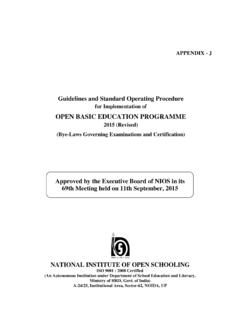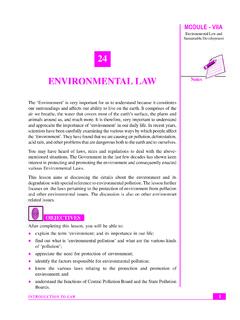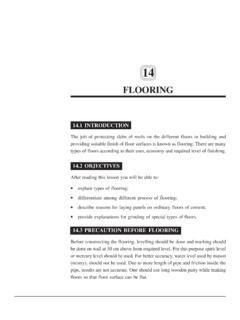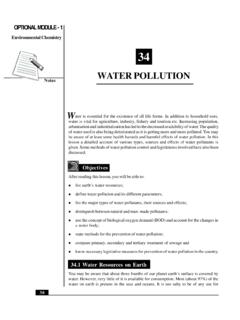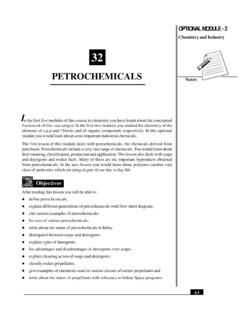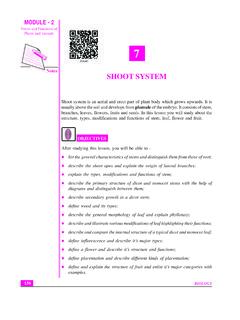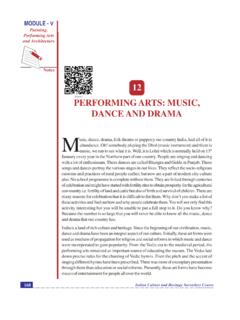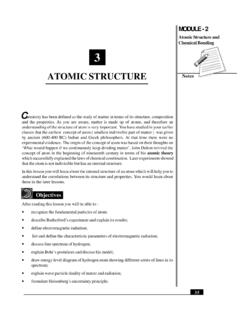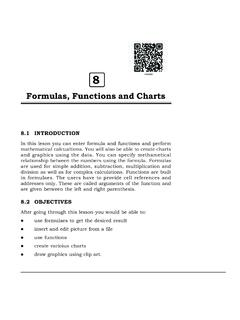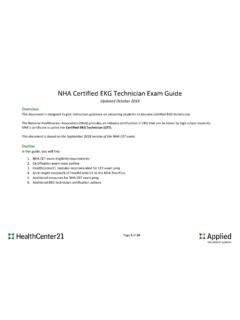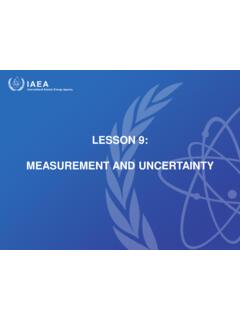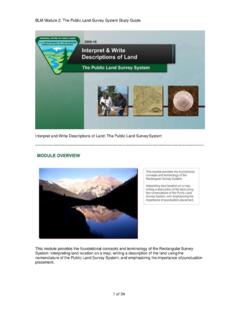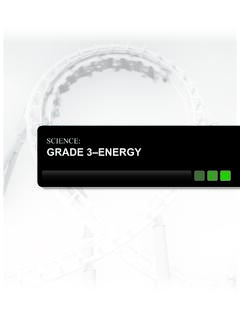Transcription of 9 MEASURES OF DISPERSION - National Institute of Open ...
1 MODULE - 4 MEASURES of DISPERSION Statistical Tools 9. Notes MEASURES OF DISPERSION . The previous lesson provides the measure of central tendency that sum up or describe the data into a single representative value. The MEASURES of central tendency may not be adequate to describe data unless we know the manner in which the individual items scatter around it. In other words, a further description of a series on the scatter or variability known as DISPERSION is necessary, if we are to gauge how representative the average is. Let us take the following three sets. Students Group X Group Y Group Z.
2 1 50 45 05. 2 50 50 45. 3 50 55 100. mean X 50 50 50. Thus, the three groups have same mean 50. In fact the median of group X and Y are also equal. Now if one would say that the students from the three groups are of equal capabilities, it is totally a wrong conclusion. Close examination reveals that in group X students have equal marks as the mean, students from group Y are very close to the mean but in the third group Z, the marks are widely scattered. It is thus clear that the MEASURES of the central tendency is alone not sufficient to describe the data. The measure of DISPERSION helps us to know the degree of variability in the data and provide a better understanding of the data.
3 OBJECTIVES. After completing this lesson, you will be able to: z know the meaning and need of MEASURES of DISPERSION ;. 146 ECONOMICS. MEASURES of DISPERSION MODULE - 4. Statistical Tools z distinguish between absolute and the relative MEASURES of DISPERSION ;. z apply the various MEASURES of DISPERSION ; and z calculate and compare the different MEASURES of DISPERSION . MEANING OF DISPERSION . DISPERSION is the extent to which values in a distribution differ from the average Notes of the distribution. In measuring DISPERSION , it is imperative to know the amount of variation (absolute measure ) and the degree of variation (relative measure ).
4 In the former case we consider the range, Quartile Deviation, standard deviation etc. In the latter case we consider the coefficient of range, coefficient quartile deviation, the coefficient of variation etc. Absolute and Relative MEASURES of DISPERSION The DISPERSION of a series may be measured either absolutely or relatively. If the DISPERSION is expressed in terms of the original units of the series, it is called absolute measure of DISPERSION . The disadvantage of absolute measure of DISPERSION is that it is not suitable for comparative study of the characteristics of two or more series.
5 For example if the data is expressed in kilograms then the absolute variation will also be expressed in kilograms but if the same data is expressed in grams then the variation will appear 1000 times more. So for comparison point of view it is necessary to calculate the relative MEASURES of DISPERSION which are expressed as percentage form ( unitless number). These types of expressions are called coefficients of DISPERSION . Each absolute measure of DISPERSION has a relative measure of DISPERSION . MEASURES AND METHODS OF COMPUTING. DISPERSION . The following are the important MEASURES of DISPERSION : 1.
6 Range 2. Quartile deviation or Semi-Inter quartile range. 3. Mean deviation 4. Standard deviation 5. Lorenz Curve ECONOMICS 147. MODULE - 4 MEASURES of DISPERSION Statistical Tools Range and Quartile Deviation measure the DISPERSION by calculating the spread within which the values lie. Mean Deviation and Standard Deviation calculate the extent to which the values differ from the average. Range Range (R) is the difference between the largest (L) and the smallest value (S) in Notes a distribution. Thus Range (R) = L S. Coefficient of Range: It is a relative measure of the range. It is used in the comparative study of the DISPERSION L S.
7 Co-efficient of Range =. L+S. In case of continuous series Range is just the difference between the upper limit of the highest class and the lower limit of the lowest class. Range: Evaluation Range is very simple to understand and easy to calculate. However, it is not based on all the observations of the distribution and is unduly affected by the extreme values. Any change in the data not related to minimum and maximum values will not affect range. It cannot be calculated for open-ended frequency distribution. Example 1: The amount spent (in `) by the group of 10 students in the school canteen is as follows: 110, 117, 129, 197, 190, 100, 100, 178, 255, 790.
8 Find the range and the co-efficient of the range. Solution: R = L - S = 790 - 100 = ` 690. L S 790 100 690. Co-efficient of Range = = = = L + S 790 + 100 890. Example 2: Find the range and it's co-efficient from the following data. Size 10-20 20-30 30-40 40-50 50-100. Frequency 2 3 5 4 2. Solution: R = L S = 100 10 = 90. 148 ECONOMICS. MEASURES of DISPERSION MODULE - 4. Statistical Tools L S 100 10 90. Co-efficient of range = = = = L + S 100 + 10 110. INTEXT QUESTIONS Notes 1. The difference between the largest and the smallest data values is the (a) variance (b) inter-quartile range (c) range (d) coefficient of variation 2.
9 A researcher has collected the following sample data. The mean of the sample is 5. 3 5 12 3 2. The range is (a) 1 (b) 2 (c) 10 (d) 12. Quartile Deviation It is based on the lower quartile Q1 and the upper quartile Q3. The difference Q3 Q1 is called the inter-quartile range. The difference Q3 Q1 divided by 2 is called semi-inter-quartile range or the quartile deviation. Q3 Q1. Thus Quartile Deviation ( ) =. 2. Coefficient of Quartile Deviation A relative measure of DISPERSION based on the quartile deviation is called the coefficient of quartile deviation. It is defined as Q3 Q1. 2 Q Q1.
10 Coefficient of Quartile Deviation = = 3. Q3 + Q1 Q3 + Q1. 2. It is pure number free of any units of measurement . It can be used for comparing the DISPERSION in two or more than two sets of data. Computation of Quartile Deviation of Ungrouped Data Example 3: Find out the quartile deviation of daily wages (in `) of 7 persons is given below:120,70,150,100,190,170,250. ECONOMICS 149. MODULE - 4 MEASURES of DISPERSION Statistical Tools Solution: Arranging the data in an ascending order we get 70, 100, 120, 150, 170, 190, 250. Here n = 7, Notes (N + 1). Q1 = Size of th item 4. (7 + 1). = Size of th item = 2nd item = 100 rupees 4.

